The fuel vapor may dwell in the case longer, but the oil does not, as its loiter time is determined mostly by rpm.That the fuel evaporates out is not relevant to my point that the oil in a strato spends a greater number of degrees of crankshaft rotation in the case than it does in a conventional engine. The rpm is also not relevant as each rotation is a separate event, at higher rpm more oil will be brought in sooner (the next rotation), and both the oil and the fuel are continually moving through.
I agree with you that there is some 20% less oil moving through the case, but I disagree that this translates to 20% less "lubrication" in all areas, as the situation is more complex than that. And with a variety of strato saws on the market for over 10 years I think we'd have seen evidence of some inherent problem with the technology if there were one (setting aside any possible design flaws on specific saws).
You are using an out of date browser. It may not display this or other websites correctly.
You should upgrade or use an alternative browser.
You should upgrade or use an alternative browser.
Will Strato charged motors be less reliable long term?
- Thread starter bwalker
- Start date

Help Support Arborist Forum:
This site may earn a commission from merchant affiliate
links, including eBay, Amazon, and others.
Ported saws also make more HP...To quote ChrisPa
It is a fact that a strato has maybe 20% less fuel mix moving through the case per revolution. The rest of the claims are not as clear:
This thread is about the longevity which the manufacturer uses as a design parameter. Adding in modified from stock brings in complication.
Paragon Builder
AS Enthusiast
- Joined
- Nov 27, 2014
- Messages
- 3,029
- Reaction score
- 3,078
Why is oil dwell time determined by rpm and fuel vapor not?The fuel vapor may dwell in the case longer, but the oil does not, as its loiter time is determined mostly by rpm.
Chris-PA
Where the Wild Things Are
Could you explain your reasoning here more?The fuel vapor may dwell in the case longer, but the oil does not, as its loiter time is determined mostly by rpm.
Fuel and oil are metered into the case in a continuous flow from carb/intake port to transfer port and cylinder. Neither fuel or oil can accumulate in the case to any degree. The fuel may vaporize more easily and some of the oil may condense out and stick to parts in the case, but all of it eventually passes from the case, into the cylinder and out the exhaust. This was part of my reasoning that the reduced volume of fuel/oil mix flowing through the case does not translate directly into an equivalently reduced lubrication capability. The reduced flow may well effect crank bearings, rod bearings and cylinder walls differently.
Your not considering several things.... it is a fact a strato engine has less lubricant available to it. The strato design from a lubrication stand point are the same as a traditional two stroke.
Maybe I'm not considering several things, but you talk as though you have hours of study into this subject and are the final authority - and that there are no other possibilities, and you seem unopen to the possibility that your "concept" of how all this works may not be the be-all, end-all. Chris-PA has a very solid grasp of the concept, but you just keep repeating 20% less fuel consumption = 20% less lubrication and I don't believe that is the case. I think it's way deeper than that. If the traditional 2-stroke is 20% less efficient, that means that it was spewing more unburnt fuel mix out the exhaust, and you have no way of knowing that the extra 20% was making contact with critical internal surfaces requiring lubrication.
I'm not here to argue, just like to learn. Just seems others offer technical explanations and you just keep repeating the same thing over and over as if you are brainwashed, lol. Don't feel bad though, I've felt I was right about stuff and argued it into the ground only to have to eat crow when I found out I was wrong. Not saying you are wrong; just saying you seem to be closed minded to other possibilities.
As far as larger sump capacities on automobiles, lots of reasons I can think of for that. One that I can think of is that mfg's are constantly trying to extend oil change intervals. 3K miles used to be the norm; now it's not uncommon to see 10K and even 15K OCI. I know some current engines due to design and running at higher temperatures suffer from sludging problems. One solution is more frequent OCI; another solution is larger sump capacity. I did not know that several of the 4 bangers are now holding 6 quarts. Which models? My wife's VW TDI 4 cylinder holds 4.5 I think. I see that the 4 cylinder in the camry 2.5 4 cylinder is 4.7 quarts. Interesting.
Waylan
I keep reading a lot of opinions but nothing has been supported with facts. We need to have the orginal poster write a 2 page paper with references listed in mla format, on why he thinks strato engine lubricate less. Then somebody on the oppossing side write a 2 page paper on why the lubricate better that tradional 2 stroke engines. This will stop slot of FOOLISHNESS on the site.
I motion a new rule that every argument on arboristsite be supported with sound research and references. Can I get a second?
I motion a new rule that every argument on arboristsite be supported with sound research and references. Can I get a second?
STIHLTHEDEERE
This is Koty
Yeh, that's all he is able to do is talk, reading his posts it is easy to see he talks out of his rear end. He is definitely a self proclaimed expert. "This is only applicable in the chainsaw world". Says the king of the idiots!!!!Maybe I'm not considering several things, but you talk as though you have hours of study into this subject and are the final authority - and that there are no other possibilities, and you seem unopen to the possibility that your "concept" of how all this works may not be the be-all, end-all. Chris-PA has a very solid grasp of the concept, but you just keep repeating 20% less fuel consumption = 20% less lubrication and I don't believe that is the case. I think it's way deeper than that. If the traditional 2-stroke is 20% less efficient, that means that it was spewing more unburnt fuel mix out the exhaust, and you have no way of knowing that the extra 20% was making contact with critical internal surfaces requiring lubrication.
I'm not here to argue, just like to learn. Just seems others offer technical explanations and you just keep repeating the same thing over and over as if you are brainwashed, lol. Don't feel bad though, I've felt I was right about stuff and argued it into the ground only to have to eat crow when I found out I was wrong. Not saying you are wrong; just saying you seem to be closed minded to other possibilities.
As far as larger sump capacities on automobiles, lots of reasons I can think of for that. One that I can think of is that mfg's are constantly trying to extend oil change intervals. 3K miles used to be the norm; now it's not uncommon to see 10K and even 15K OCI. I know some current engines due to design and running at higher temperatures suffer from sludging problems. One solution is more frequent OCI; another solution is larger sump capacity. I did not know that several of the 4 bangers are now holding 6 quarts. Which models? My wife's VW TDI 4 cylinder holds 4.5 I think. I see that the 4 cylinder in the camry 2.5 4 cylinder is 4.7 quarts. Interesting.
Waylan
Yeh, that's all he is able to do is talk, reading his posts it is easy to see he talks out of his rear end. He is definitely a self proclaimed expert. "This is only applicable in the chainsaw world". Says the king of the idiots!!!!
Not sure I'm comfortable with you siding with me, lol. You've come across in this thread as a real jackass. I'm not calling bwalker out, just asking for something other than repetitive regurgitation of the same thing over and over.
Alot can be determined by the attitude a person exhibits on a forum like this. I've got alot of respect for other dealers that have been members in the past or currently. When Lakeside used to be on here, I eagerly read whatever he had to say - it was full of knowledge and you could tell he was well versed and really brought alot of helpful information to the table. Spike60 as well - he holds his tongue 95% of the time, and when he does speak it is very respectful and very knowledgeable. I like TLandrum as well. Those are the kind of guys I like to deal with. I like stihl products and think they are a good company, but if you were my dealer posting the stuff you do on here, I would consider changing dealers. Good dealers should be posting useful information to the multitudes, leaking upcoming products, have patience with those that may not understand something and be willing to break technical information down if needed. Not chest pounding, talking about how many hundreds of thousands of dollars they have made on the back of Stihl. My words here are probably wasted, and are just my opinion.
I don't like to see the arguing between Windthrown and Snelling - I've got alot of respect for both of these guys. Even though I've not modified a saw, I have a basic understanding of the timing, blowdown, etc. that is discussed. For this reason I can see why Snelling and Randy Evans both say it's a traditional saw as it is not a solid departure from traditional design like the strato design. If I degreed the saws myself I'm inclined that I would believe what I saw considering that Stihl IS guilty of rebadging old technology as something new. In Windthrown's defense, obviously Stihl has tweaked something to make this engine more efficient that requires the flow diverter, but the tweaking is so minor that it's not clearly evident and doesn't add up. I'd say the truth is somewhere between and I'd just like the guys to get along. None of THESE guys have lost any of my respect, not that my respect was worth anything to start with.
Waylan
just because you disagree he is a jackass....civility goes a long way in making someone see your side of the argument even if in the end they still dont agree. And name calling just makes you look bad.Are you really that stupid ? What a jackass.
i personally think they lubricate less and that there may be some longevity issues with SOME strato saws. Lots of factors likely play a role in all of this and so far from personal experience I think there are some issues but i am open to both sides and would like to be proven wrong.
Looking at this logically, it seems to me that the bottom end of a strato saw would have to be receiving less lubrication. Oil laden fuel enters the crankcase, the fuel vaporizes, and the oil falls out of suspension. This oil is now present and available to lubricate the bottom end. Whether or not the air that carried this oil in was wasted to exhaust spent gases is irrelevant at this stage. It's in the crankcase, period. Turbulence and air flow cause this oil to migrate to the topend. It seems reasonable that this would be highly affected by RPM, which is why engines that see extended high RPM use need a heavier mix ratio. Careful tuners actually measure the amount of residual oil in the crankcase in order to determine the proper mix ratio for a given application. This will vary by engine and operator. With this thought, I would be far more hesitant to run a thinner mix ratio in a strato saw.
These pics are of a 441, used extensively for milling, running on 50:1 Bailey's Full Synthetic. I credit a good oil with saving this saw.
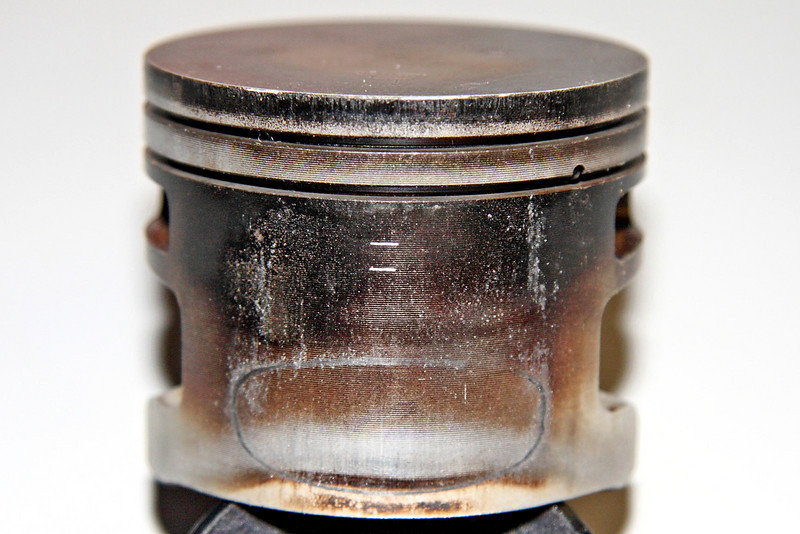
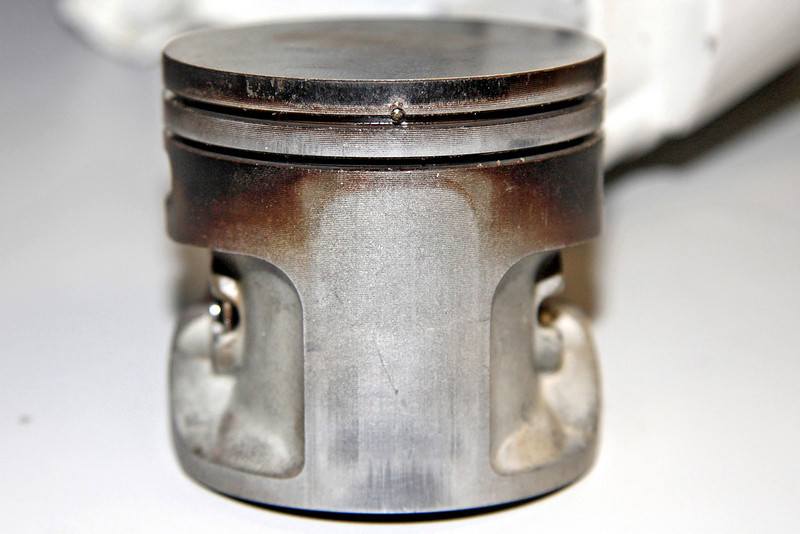
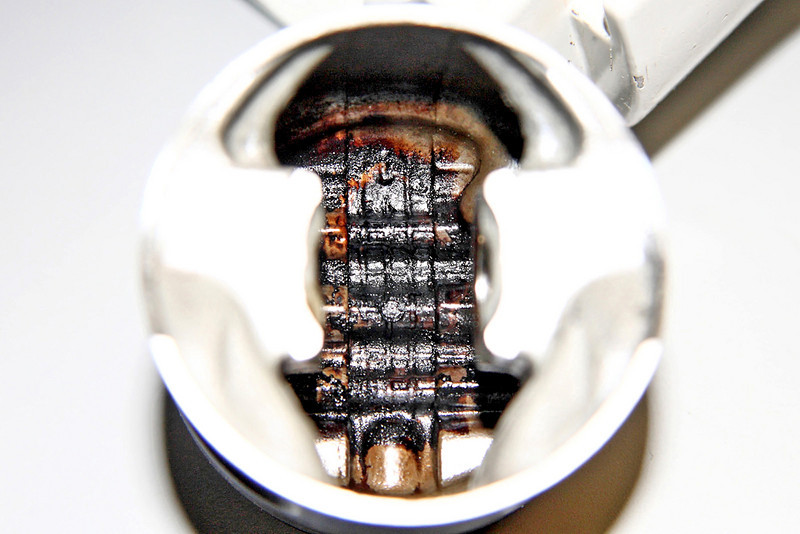
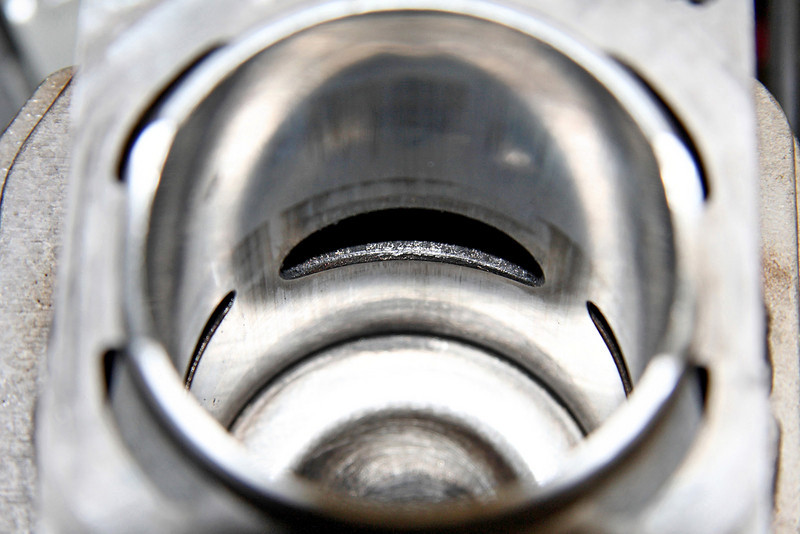
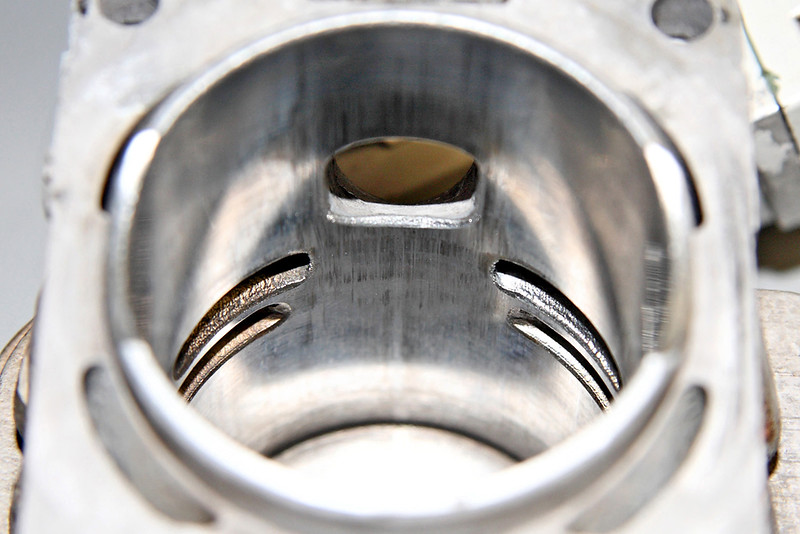
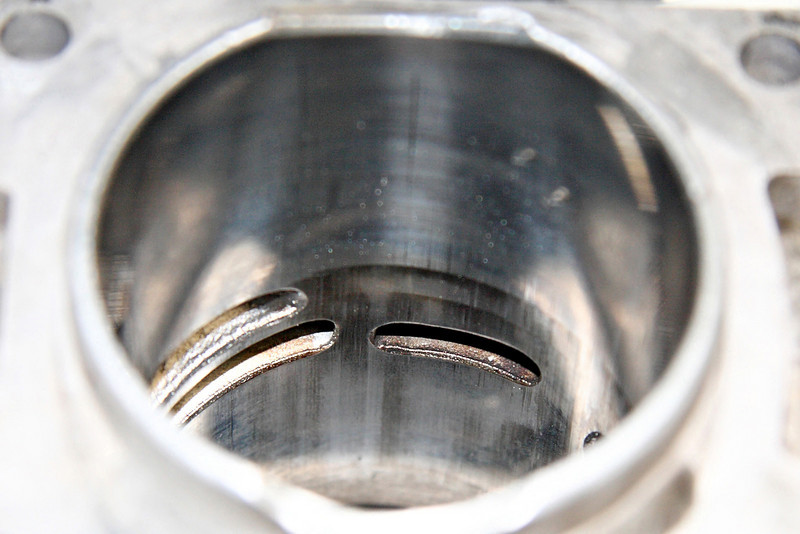
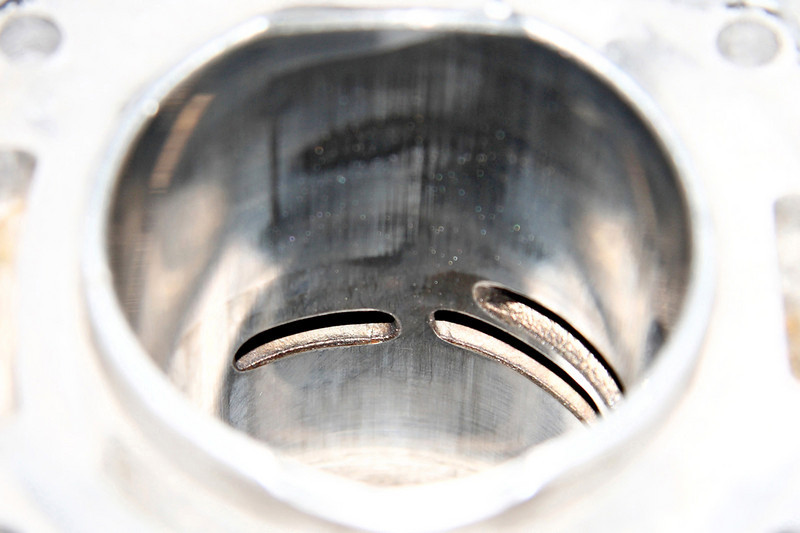
These pics are of a 441, used extensively for milling, running on 50:1 Bailey's Full Synthetic. I credit a good oil with saving this saw.







Chris-PA
Where the Wild Things Are
OK, but how can we tell if that was a lubrication or a cooling issue? There was clearly heat and cooked oil on the bottom of the piston - someone with experience could likely tell if lubrication contributed to that, or if the heat was due to other causes.These pics are of a 441, used extensively for milling, running on 50:1 Bailey's Full Synthetic. I credit a good oil with saving this saw.
I don't have that knowledge/experience, but I don't see excessive wear, just cooked oil.
the GOAT
Chainsaw truther
I remember that threadLooking at this logically, it seems to me that the bottom end of a strato saw would have to be receiving less lubrication. Oil laden fuel enters the crankcase, the fuel vaporizes, and the oil falls out of suspension. This oil is now present and available to lubricate the bottom end. Whether or not the air that carried this oil in was wasted to exhaust spent gases is irrelevant at this stage. It's in the crankcase, period. Turbulence and air flow cause this oil to migrate to the topend. It seems reasonable that this would be highly affected by RPM, which is why engines that see extended high RPM use need a heavier mix ratio. Careful tuners actually measure the amount of residual oil in the crankcase in order to determine the proper mix ratio for a given application. This will vary by engine and operator. With this thought, I would be far more hesitant to run a thinner mix ratio in a strato saw.
These pics are of a 441, used extensively for milling, running on 50:1 Bailey's Full Synthetic. I credit a good oil with saving this saw.







http://www.arboristsite.com/community/threads/what-would-cause-this.119470/
I see sign of LOTS of heat. I credit a good oil for saving the saw. I believe a richer tune, limiters were still intact, and a heavier oil mix would have prevented the excessive heat this saw experienced.OK, but how can we tell if that was a lubrication or a cooling issue? There was clearly heat and cooked oil on the bottom of the piston - someone with experience could likely tell if lubrication contributed to that, or if the heat was due to other causes.
I don't have that knowledge/experience, but I don't see excessive wear, just cooked oil.
Could not have been said better!Not sure I'm comfortable with you siding with me, lol. You've come across in this thread as a real jackass. I'm not calling bwalker out, just asking for something other than repetitive regurgitation of the same thing over and over.
Alot can be determined by the attitude a person exhibits on a forum like this. I've got alot of respect for other dealers that have been members in the past or currently. When Lakeside used to be on here, I eagerly read whatever he had to say - it was full of knowledge and you could tell he was well versed and really brought alot of helpful information to the table. Spike60 as well - he holds his tongue 95% of the time, and when he does speak it is very respectful and very knowledgeable. I like TLandrum as well. Those are the kind of guys I like to deal with. I like stihl products and think they are a good company, but if you were my dealer posting the stuff you do on here, I would consider changing dealers. Good dealers should be posting useful information to the multitudes, leaking upcoming products, have patience with those that may not understand something and be willing to break technical information down if needed. Not chest pounding, talking about how many hundreds of thousands of dollars they have made on the back of Stihl. My words here are probably wasted, and are just my opinion.
I don't like to see the arguing between Windthrown and Snelling - I've got alot of respect for both of these guys. Even though I've not modified a saw, I have a basic understanding of the timing, blowdown, etc. that is discussed. For this reason I can see why Snelling and Randy Evans both say it's a traditional saw as it is not a solid departure from traditional design like the strato design. If I degreed the saws myself I'm inclined that I would believe what I saw considering that Stihl IS guilty of rebadging old technology as something new. In Windthrown's defense, obviously Stihl has tweaked something to make this engine more efficient that requires the flow diverter, but the tweaking is so minor that it's not clearly evident and doesn't add up. I'd say the truth is somewhere between and I'd just like the guys to get along. None of THESE guys have lost any of my respect, not that my respect was worth anything to start with.
Waylan

Brad gets it!Looking at this logically, it seems to me that the bottom end of a strato saw would have to be receiving less lubrication. Oil laden fuel enters the crankcase, the fuel vaporizes, and the oil falls out of suspension. This oil is now present and available to lubricate the bottom end. Whether or not the air that carried this oil in was wasted to exhaust spent gases is irrelevant at this stage. It's in the crankcase, period. Turbulence and air flow cause this oil to migrate to the topend. It seems reasonable that this would be highly affected by RPM, which is why engines that see extended high RPM use need a heavier mix ratio. Careful tuners actually measure the amount of residual oil in the crankcase in order to determine the proper mix ratio for a given application. This will vary by engine and operator. With this thought, I would be far more hesitant to run a thinner mix ratio in a strato saw.
These pics are of a 441, used extensively for milling, running on 50:1 Bailey's Full Synthetic. I credit a good oil with saving this saw.







Chris-PA
Where the Wild Things Are
Ok that's probably all true, but saying good oil may have saved an overheating engine is quite different from saying that reduced oil flow from it being a strato was the cause.I see sign of LOTS of heat. I credit a good oil for saving the saw. I believe a richer tune, limiters were still intact, and a heavier oil mix would have prevented the excessive heat this saw experienced.
If you think that's going to happen pack sand.I keep reading a lot of opinions but nothing has been supported with facts. We need to have the orginal poster write a 2 page paper with references listed in mla format, on why he thinks strato engine lubricate less. Then somebody on the oppossing side write a 2 page paper on why the lubricate better that tradional 2 stroke engines. This will stop slot of FOOLISHNESS on the site.
I motion a new rule that every argument on arboristsite be supported with sound research and references. Can I get a second?
The things that are argued about here are pretty well cut and dried.
It's not my job to be your educator and you shouldn't comment if you have no knowledge.
Ok that's probably all true, but saying good oil may have saved an overheating engine is quite different from saying that reduced oil flow from it being a strato was the cause.
I agree, but I don't have enough experience to know. I would venture to guess that just tuning itself (more evaporative cooling + more oil due to richer tuning) may have been enough on it's own. That does not mean that I wouldn't be running a higher ratio of oil to fuel as I agree, but I think that's the norm when it comes to milling, especially with a 70cc saw. Don't get me wrong, I'm not saying that a 440 or 372 with similar tune would or would not have looked the same - but to test this would take quite a bit of work. Along the lines of what Chad (I think that's his name) has done on the dyno. EGT measurements to set the tune on a non-strato and a strato of the same displacement, then run hard for the same amount of time in the same scenario (milling), and that would give you a single data point. Doesn't mean that all stratos would compare the same as there are different designs.
I think the truth is out there, but I think the ones in the camp that believe it's as simple as stratos use less fuel so are lubricated less across the board are not 100% right. What % right they are I have no idea.
Waylan
Maybe I'm not considering several things, but you talk as though you have hours of study into this subject and are the final authority - and that there are no other possibilities, and you seem unopen to the possibility that your "concept" of how all this works may not be the be-all, end-all. Chris-PA has a very solid grasp of the concept, but you just keep repeating 20% less fuel consumption = 20% less lubrication and I don't believe that is the case. I think it's way deeper than that. If the traditional 2-stroke is 20% less efficient, that means that it was spewing more unburnt fuel mix out the exhaust, and you have no way of knowing that the extra 20% was making contact with critical internal surfaces requiring lubrication.
I'm not here to argue, just like to learn. Just seems others offer technical explanations and you just keep repeating the same thing over and over as if you are brainwashed, lol. Don't feel bad though, I've felt I was right about stuff and argued it into the ground only to have to eat crow when I found out I was wrong. Not saying you are wrong; just saying you seem to be closed minded to other possibilities.
As far as larger sump capacities on automobiles, lots of reasons I can think of for that. One that I can think of is that mfg's are constantly trying to extend oil change intervals. 3K miles used to be the norm; now it's not uncommon to see 10K and even 15K OCI. I know some current engines due to design and running at higher temperatures suffer from sludging problems. One solution is more frequent OCI; another solution is larger sump capacity. I did not know that several of the 4 bangers are now holding 6 quarts. Which models? My wife's VW TDI 4 cylinder holds 4.5 I think. I see that the 4 cylinder in the camry 2.5 4 cylinder is 4.7 quarts. Interesting.
Waylan
The subjects being argued about here are tantamount to arguing the earth is round. Pretty simple stuff.Maybe I'm not considering several things, but you talk as though you have hours of study into this subject and are the final authority - and that there are no other possibilities, and you seem unopen to the possibility that your "concept" of how all this works may not be the be-all, end-all. Chris-PA has a very solid grasp of the concept, but you just keep repeating 20% less fuel consumption = 20% less lubrication and I don't believe that is the case. I think it's way deeper than that. If the traditional 2-stroke is 20% less efficient, that means that it was spewing more unburnt fuel mix out the exhaust, and you have no way of knowing that the extra 20% was making contact with critical internal surfaces requiring lubrication.
I'm not here to argue, just like to learn. Just seems others offer technical explanations and you just keep repeating the same thing over and over as if you are brainwashed, lol. Don't feel bad though, I've felt I was right about stuff and argued it into the ground only to have to eat crow when I found out I was wrong. Not saying you are wrong; just saying you seem to be closed minded to other possibilities.
As far as larger sump capacities on automobiles, lots of reasons I can think of for that. One that I can think of is that mfg's are constantly trying to extend oil change intervals. 3K miles used to be the norm; now it's not uncommon to see 10K and even 15K OCI. I know some current engines due to design and running at higher temperatures suffer from sludging problems. One solution is more frequent OCI; another solution is larger sump capacity. I did not know that several of the 4 bangers are now holding 6 quarts. Which models? My wife's VW TDI 4 cylinder holds 4.5 I think. I see that the 4 cylinder in the camry 2.5 4 cylinder is 4.7 quarts. Interesting.
Waylan
And do realised a traditional two stroke deposits it's the vast majority of its oil in the crankcase as soon as the fuel air mix enters. You are not considering this, nor.oil.migration times and what effects them.in your argument.
Brad gets it!
I think anybody that agrees with you on this will automatically fall into your "smart" category. And anybody that disagrees doesn't know what they're talking about, lol. I think I am in the latter, but that's ok. All this is good food for thought. Seems us chainsawers just like to overthink everything and I enjoy it. It's like oil threads, bar threads, stihl versus husky, autotune versus mtronic. Any decent model, regardless of manufacturer, when tuned correctly, and run at mfg specified ratios, even with ethanol fuel, will typically perform adequately. If the less oil available in strato saws is true, with so few failing I'd have to think that there was simply too much oil available on the original non-strato saws.
Question to the builders - Brad is the main builder remaining active in this thread - when you tear down strato saws for porting or whatever, do you typically see an oil coating similar to what you would find in a non-strato saw of similar size? I know this can depend on mix ratio and tune as well, but just wondering. I've seen pics of saws torn down with a nice layer of oil coating most of the internal surfaces - is this typically not the case on strato saws?
Waylan
Similar threads
- Replies
- 61
- Views
- 4K



